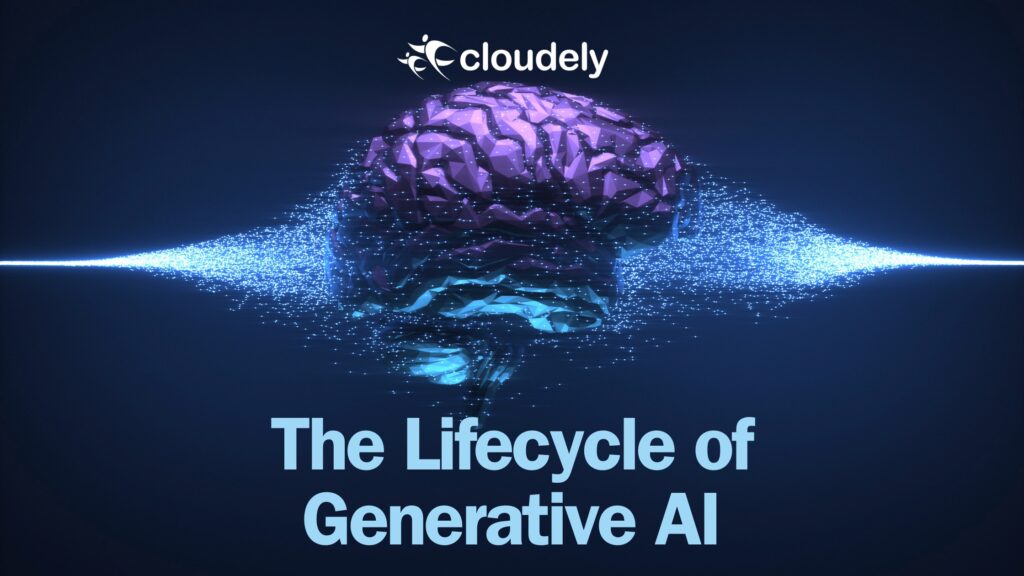What if you could create anything simply by describing it? From essays to artwork to computer code, generative AI promises to revolutionize content production. However, this emerging technology only appeared after a while. Understanding the lifecycle of generative AI models reveals the innovation, investment, and infrastructure that enables their uncanny abilities. As these systems continue advancing rapidly, what does the future hold for their development and adoption? Delve deeper into their origins and trajectory with this comprehensive guide.
What is Generative AI?
Generative AI refers to machine learning systems that can create novel, realistic artifacts like text, code, images, video, or audio simply from a text description, with little to no human involvement.
Generative AI uses powerful deep learning models to learn patterns from vast datasets, producing original, customized content at scale. However, developing generative AI capabilities is a challenging feat. It involves well-defined stages from problem definition to ongoing model improvement. Curiosity about the inner workings of generative AI models is growing as their content automation potential is realized.
Critical capabilities of generative AI systems include:
- Text generation – Creating coherent narratives, prose, poetry, and news articles based on text prompts
- Image generation – Producing photorealistic images from textual descriptions
- Video generation – Assembling synthetic video based on textual storyline cues
- Data generation – Automatically generating synthetic datasets for training AI models
- Code generation – Automatically writing computer programs from natural language descriptions
Developing Generative AI Systems
The stages below form a flywheel – as models deploy into products and services, they gather user data to improve subsequent versions:
1. Idea Generation and Planning
The initial step is defining the specific problem or opportunity that generative AI could address. This involves researching existing techniques, identifying target outcomes, and establishing evaluation metrics. For example, a publisher may aim to automate article generation about specific topics to increase output. Or a healthcare startup may use AI to synthesize medical studies at scale. Careful upfront planning guides later stages and ensures the model serves its intended purpose.
2. Data Collection and Preprocessing
With goals clarified, relevant data must be identified and prepared for model training. Sources may include public datasets, proprietary data warehouses, or synthetically generated samples. Rigorous preprocessing like sampling, cleaning, and labeling converts raw data into a standardized format the model can learn from. Bias checks are critical at this stage to avoid promoting harmful stereotypes later on. Metadata tracking preserves information about the provenance and properties of curated data.
3. Model Architecture and Training
Next, a model architecture is selected to match the task – text transformers and convolutional networks for images. The preprocessed data updates model parameters via algorithms like backpropagation iteratively. Hyperparameters governing batch size, learning rate, and more are tuned. Monitoring loss and other metrics helps determine when training should conclude. Pretrained models can accelerate this process through transfer learning. Proper model selection and extensive training are foundations of high-quality generative output.

4. Evaluation and Benchmarking
Once training concludes, the model’s abilities must be rigorously evaluated. For text generation, metrics assess relevance, coherence, grammar, and ability to avoid societal biases. Image generation looks at diversity, resolution, and realism. Human evaluators provide qualitative feedback on sample outputs, too. Comparing performance to baselines established in planning indicates if the model fulfills its potential or requires retraining. Thorough benchmarking gives insights to improve later iterations.
5. Model Deployment
With a high-performing generative model, the next step is operationalizing it through deployment. This typically involves containerization to package the model for production environments. Specialized endpoints enable scalable hosting and real-time request processing. Monitoring tools track latency, error rates, and resource consumption over time. Careful deployment is vital to reliable, stable model operation after development.
6. Content Generation and Delivery
The model generates and delivers new content to end users via APIs or applications at this stage. Input prompts and conditional parameters produce customized outputs. Post-generation processing may edit or format results as needed. Effective delivery mechanisms distribute AI-generated materials like blog articles, tweets, images, or documents to target audiences through appropriate communication channels.
7. Continuous Improvement
Even after deployment, the generative AI lifecycle does not end. New data is continually monitored for concept and distribution shifts requiring model retraining or architecture changes. Feedback informs prompt and data optimizations. Updates safeguard performance over time in dynamic real-world environments. Constant assessment of legal and ethical implications drives responsible evolution.
Final Thoughts
This in-depth look at the generative AI lifecycle shows that developing powerful AI models involves meticulous, multi-stage processes from ideation to delivery. While generative algorithms offer incredible automation potential, success depends on addressing each phase with scientific rigor and best practices. With skilled development and deployment, generative AI has the potential to transform content production -fueling new business models, scientific discovery, and more. The future of AI creation lies in complete understanding and control of its lifecycle.
